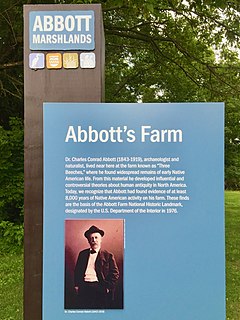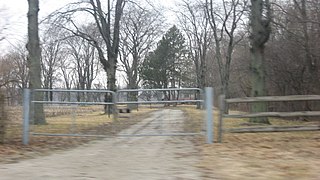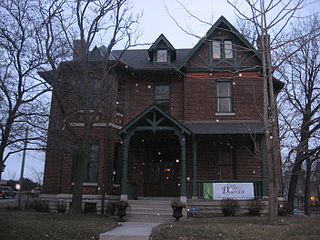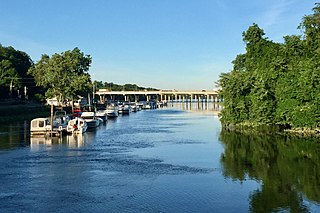Related Research Articles
List of the National Register of Historic Places listings in Kent County, Delaware
This is a list of properties on the National Register of Historic Places in northern New Castle County, Delaware.

Mason Neck State Park is located in Fairfax County, Virginia. The park is on a peninsula formed by Pohick Bay on the north, Belmont Bay on the south and the Potomac River to the east. The park has an area of 1,814 acres (7.34 km2) and is home to bald eagles, great blue herons, ospreys, and many other types of wildlife. The park also contains white-tailed deer and many species of lichen.

The Eaker Site (3MS105) is an archaeological site on Eaker Air Force Base near Blytheville, Arkansas that was declared a National Historic Landmark in 1996. The site is the largest and most intact Late Mississippian Nodena Phase village site within the Central Mississippi Valley, with archaeological evidence indicating a palisaded village some 50 acres (20 ha) in size, with hundreds of structures. The site's major period of occupation was 1350–1450 CE, although evidence of occupation dates back to 600 CE. The site is also hypothesized to have been occupied by the Quapaw prior to a migration further south, after which they made contact with Europeans in the late 17th century.

The Abbott Farm Historic District is a National Historic Landmark archaeological site in New Jersey. It is the largest known Middle Woodland village of its type on the East Coast of the United States. Significant evidence suggests that the Delaware River floodplain was occupied by Paleoindian people for a long period. It was inhabited between 500 BC and 500 AD. It has been a source of controversy and debate around early development.

Sandy Neck Cultural Resources District is a historic district in Barnstable, Massachusetts. Sandy Neck is a long spit of land extending east-west on the northern shore of the lower portion of Cape Cod, sheltering Barnstable Harbor. This area has a fairly lengthy history of human occupation, including archaeological prehistoric and colonial historic resources. Archaeological research in the 1960s identified shell middens dating from the pre-contact Woodland Period.

Omar is an unincorporated community in Sussex County, Delaware, United States, located at the crossroads of Delaware Route 20 and Sussex County Road 54 and between the towns of Dagsboro and Roxana.

The Murphy Mound Archeological Site, is a prehistoric archaeological site in the Bootheel region of the U.S. state of Missouri. Located southwest of Caruthersville in Pemiscot County, Missouri the site was occupied by peoples of the Late Mississippian period, centuries before European colonization of the area.

The Dodge Site is an archaeological site in the northwestern part of the U.S. state of Ohio. Located north of Bowling Green in Wood County, the site was inhabited by Middle Woodland and Upper Mississippian peoples. Among the artifacts discovered at the site are ceramics and stone tools. The site's stratigraphy is obvious: the Middle Woodland village site and cemetery can easily be distinguished from the Upper Mississippian occupation zone that sits on top of it. While only a small portion of the 2.2 acre (0.89 ha) site has been excavated, the artifacts that have been discovered at Dodge have contributed significantly to an understanding of the western basin of Lake Erie around AD 1300. Enough material has been recovered to facilitate radiometric dating, as well as identifying the peoples who once inhabited the site. The excavations also revealed the intensity of occupation: the Middle Woodland layer was substantially larger than the exceptionally thin Upper Mississippian component.
The Ufferman Site is an archaeological site in the central part of the U.S. state of Ohio. Located north of the city of Delaware, it occupies approximately 2 acres (0.81 ha) of land near Delaware Lake on property near to the boundaries of Delaware State Park. It appears to have been the location of a village of the Cole culture, which inhabited the region during the later portion of the Woodland period. Ufferman lies only 0.6 kilometres (0.37 mi) south of the W.S. Cole Site, the type site for the culture, and approximately 23 kilometres (14 mi) north of the Highbank Park Works, which are believed to have been built by peoples of the Cole culture.

The Summer Island Site, designated 20DE4, is an archaeological site located on the northwest side of Summer Island, in Delta County, Michigan. It is classified as a stratified, multi-component site with Middle Woodland, Upper Mississippian and Early Historic/Protohistoric occupations. It was listed on the National Register of Historic Places in 1971.
Thompsons Island Site is an archaeological site located near Rehoboth Beach, Sussex County, Delaware. Thompson's Island was first identified as an archaeological site in 1942. The Delaware Department of Natural Resources and Environmental Control acquired the property in January 1990. The site appears to have functioned as a micro-band base camp, repeatedly re-occupied by small groups of people for several weeks at a time. No extensive occupation appears to have taken place before the beginning of the Woodland I Period, about 3000 B.C., with the greatest intensity of occupation on Thompson's Island occurred between 500 B.C. and A.D. 0; the time period associated with the Wolfe Neck and Delmarva Adena cultural complexes.

The Coombe Historic District is a national historic district located at Felton, Kent County, Delaware. It encompasses two contributing buildings and one contributing structure near the town of Felton representing an unusual mixture of archaeological resources, both prehistoric and historic, in combination with two excellent examples of domestic architecture from the 18th and 19th centuries. They are the brick Benjamin Coombe House, built in 1778, and the frame Caldwell House, built about 1872, with their respective outbuildings. It also includes the Hopkins Cemetery, begun in the late-19th century, and three historic archaeological house sites, as well as an area of prehistoric occupation that was listed in the National Register of Historic Places in 1979 as "Area F" in the Hughes Early Man Complex.

Poplar Thicket, also known as Marian R. Okie Memorial Wildlife Preserve at Poplar Thicket, is an archaeological site located in Long Neck, Delaware. Poplar Thicket is the name of a farm purchased by L.P. Faucett in 1918. It consists of forest, marshes, and wetlands spread across a quarter-mile of undisturbed Indian River Bayshore. Austin Okie, a grandson of Faucett, donated the property to The Nature Conservancy in October 2007, to serve as a bird refuge. The property was subsequently transferred to the state of Delaware, establishing it as the Marian R. Okie Memorial Wildlife Preserve at Poplar Thicket. The property is administered by the Delaware Department of Natural Resources and Environmental Control and serves as a bird sanctuary, used for conservation education and environmentally-sensitive activities such as bird-watching and walking.
The Byfield Historic District encompasses the remains of an early colonial community in eastern Kent County, in the U.S. state of Delaware. The district includes four separate archaeological sites, each of which have been associated with early English settlers of the area. The site designated K-929 is the location of a brick kiln, which documentary evidence suggests was associated with Daniel Jones, the first settler in the area. K-917 is speculated to be associated with William Rodney, who married Jones' daughter. K-916 is a site that may have been a slave residence, and K-890 is believed to be the site of one of the homes of Caesar Rodney, Sr., the father of Delaware Revolutionary War leader Caesar Rodney. The only 19th century structure in the district is the S. A. Sipple House.
The Hughes-Willis Site is a prehistoric Native American archaeological site in Kent County, Delaware. It is located in Dover, Delaware on the banks of the Little River, and was identified in 1971. The site contains evidence of occupation dating back 5,000 years, with its most significant occupational period being the Middle Woodland Period. Finds at the site include projectile points, and tools for cutting and scraping made of stone. The evidence suggests the site was occupied seasonally, probably sometime in the period between late fall and mid-winter.
St. Jones Neck is a geographic region of eastern central Kent County, Delaware, United States, with a rich prehistory and colonial history. Originally known just as Jones Neck, it is bounded on the west by the St. Jones River, on the north by Little Creek, and on the east by Delaware Bay. The area consists of low rolling hills that do not rise very much above sea level, interspersed with bodies of fresh and salt water. Streams are headed by marshes, and there are tidal marshlands along the bay. The neck has pockets of woodland which are concentrated near the freshwater marshes and tributaries. Land use in the neck is at present predominantly agricultural.
The Hell Island Site (7NC-F-7) is a prehistoric archaeological site located near Odessa, Delaware. The site is a type site for a class of ceramics found at other sites in the region. Artifacts recovered from the site during excavations in 1965 yielded then-distinctive tempered pottery with cordmarking on the interior and exterior, as well as evidence of occupation of the site from the Archaic to the Late Woodland Period.

St. Joseph Neighborhood Historic District is a national historic district located at Indianapolis, Indiana. The district encompasses 57 contributing buildings in a predominantly residential section of Indianapolis. It was developed between about 1855 and 1930, and include representative examples of Italianate and Queen Anne style architecture. Located in the district are the separately listed Bals-Wocher House, William Buschmann Block, Delaware Court, Pearson Terrace, and The Spink. Other notable buildings include the Christian Place complex, Fishback-Vonnegut-New House, Henry Hilker House, Apollo-Aurora Rowhouses, Israel Traub Store, and Lorenzo Moody House.

The Crosswicks Creek Site III is a historical archaeological site in the vicinity of Bordentown in Burlington County and Hamilton Township in Mercer County, New Jersey. It encompasses the remains of Revolutionary War-era ships that were sunk in Crosswicks Creek in 1778. The site was listed on the National Register of Historic Places on November 26, 1990 for its significance in military and maritime history.
References
- 1 2 "National Register Information System". National Register of Historic Places . National Park Service. July 9, 2010.
- ↑ Ronald A. Thomas (April 1976). "National Register of Historic Places Inventory/Nomination: Wolfe's Neck Site" (PDF). Delaware Department of Natural Resources and Environmental Control.

